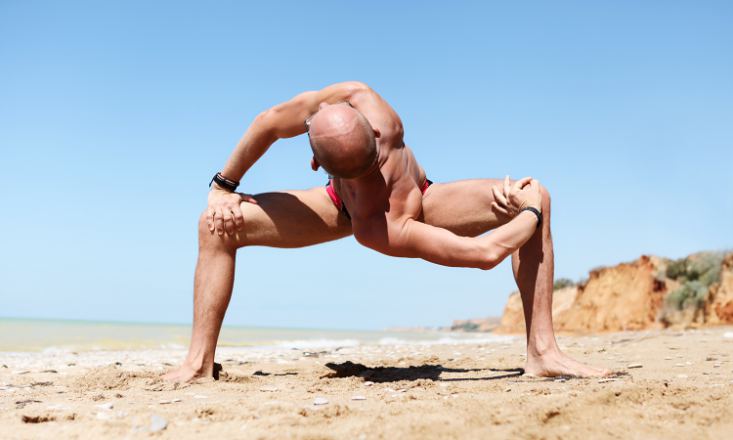Here’s a quick quiz for you:
- Do you find that you experience daily tightness and inflexibility in your body?
- Do you feel it’s a struggle on your mat to stretch your muscles?
- Do you feel as if you have muscular strength but lack flexibility?
- Can you easily touch your toes and fold forward?
- Do you often take the advanced variations of poses presented in class?
- Do you sometimes find yourself sagging in your joints when practicing yoga?
These are all questions around your degree of flexibility. The first three questions center around someone who is muscular but lacks flexibility, and the second three questions are focused on someone who is very flexible.
You might think that one of the goals of yoga practice is to increase your flexibility. True, but there is a degree of flexibility beyond which we start to actually lose the value of being flexible and start to risk injury. This is the difference between being “flexible” and being “hypermobile.”
Varying Ranges of Motion
Children are born with a great deal of flexibility, and this naturally decreases as they grow, along with their joints, muscles, and bones. As we age, there are a number of changes in the body, possible injuries, and the presence of unhealthy patterns of movement that can all create more or less flexibility.
Furthermore, there are some people who are just more flexible than others. You can think of flexibility as a “range of motion” measurement—this is how a physical therapist or physician would assess your joints during an exam.
This range is a continuum, with someone very inflexible on the one end, someone who is quite flexible on the other end, and most of everyone else in the middle. There is a healthy “range of motion” that clinicians consider “normal” and people fall inside or outside that number.
How Too Much Flexibility Hurts Us
Many people practice yoga because they want to increase their flexibility. But is it possible to be too flexible? The answer to this is not necessarily “yes,” but you can certainly say that a high degree of flexibility coupled with a low degree of awareness may increase one’s chance of injury.
Joints are the places in the body where two bones connect and are held together by ligaments. Ligaments are bands of fibrous tissue that can’t be regenerated if they break or snap off of one of the bones they were designed to support.
For this reason, it’s important that we treat ligaments with care and to support the joints with strong muscle. We also need to keep them moving to prevent scar tissue and other obstacles to healthy movement from forming.
What About Hypermobility?
Some people are “hypermobile.” This is usually something inherited, and is highlighted by joints that move well outside the normal range.
While some yoga students are used to making the appropriate pose modifications to deal with hypermobility, others might also be used to practicing with an emphasis on pushing the body to the furthest range of every muscle, because of a lack of awareness and compassion for the body.
In these cases, often the muscles, tendons, and ligaments are now stretched beyond a point where they can recover to a normal holding position.
Moving with Integrity
So, what can we do as yoga students to gain flexibility without increasing the risk of injury? We need to bring more integrity into our movements. In general, “integrity” refers to “adherence to principles, the state of being whole or being in sound and unimpaired condition.”
We can see how this would apply to yoga poses; we want to practice while adhering to principles of alignment, and we want to bring a certain kind of “wholeness” to the pose, rather than sagging in certain spots, or pushing to the fullest extent in other areas.
Here are five ways we can practice with integrity and prevent leveraging our hypermobility, which can potentially lead to injury.
1. Foundation
A steady foundation will create less of an opportunity to sag in the joints. This might mean shortening our stance, using blocks, or working with a wider stance. It might also mean ensuring we use principles of alignment, like stacking the joints for stability.
2. Awareness
When we’re not paying attention to our body in a pose, we risk sitting in our joints and practicing the same old way we always have, which might be the root of the problem. Awareness means we’re noticing how far we’re going in the pose and listening for the body’s reaction.
3. Breath
Our breath is one of the keys to staying aware in every pose. Holding the breath can be a sign we’ve pushed too far, while heavy breathing may be a sign that we’re working too hard.
4. Balancing Muscle and Stretch
Every pose has a range within it of both strength and flexibility. Practice balancing both, just like a scale that is working towards evening out.
5. Ahimsa
When we practice with a non-harming attitude, inspired by the Yamas found in the Eight Limbs of Yoga, we’re practicing for health and not for competition. This naturally leads to greater balance and less risk of injury.
Our practice is about striking a balance, both in our bodies and our minds, which work in conjunction with one another. As we bring greater awareness to the mat, we increase the overall balance in our poses from the inside out.


